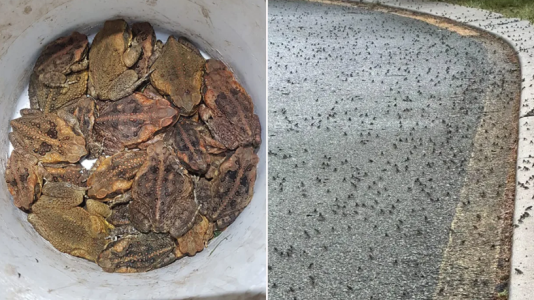You Won't Believe The Flaw That Could Derail This $1.5 Billion Battle Against An Invasive Nightmare
By
- Replies 4
Australia is a land of unique beauty, home to an array of flora and fauna found nowhere else on the planet. However, this isolated ecosystem has been under siege by invasive species, which significantly threaten our native wildlife and economy. The cost of managing these pests is staggering, with estimates of around $1.5 billion annually. It's a battle that requires innovation, coordination, and a deep understanding of ecological balance.
Recently, ABC aired 'Eat The Invaders,' a six-part series that suggests a bold plan: transforming Australia's ecological nuisances into culinary delights. The show, available online, tantalises viewers with dishes from invasive species such as carp, deer, rabbit, and cane toads. It's a concept that's as intriguing as it is controversial, and it has sparked a nationwide conversation about how we deal with these unwelcome guests.
Dr Tiana Pirtle, a conservation officer with the Invasive Species Council, acknowledges the program's role in highlighting the devastating impact of invasive species on Australia's ecosystems. However, she warns that the idea of eating our way out of the problem is not as practical or sustainable as it might seem.
One of the major flaws in this culinary approach is the sheer scale of the issue. To make a dent in the populations of these invasive species, we would need to harvest them in the millions, a task that is neither feasible nor ecologically responsible. Moreover, creating a market for these animals could backfire, increasing demand for the very species we're trying to eliminate.
Pirtle points out that commercialising invasive species could lead to a conflict of interest. Businesses that profit from selling these animals might have a vested interest in their continued presence in the landscape, which directly contradicts conservation goals.
Furthermore, indiscriminate removal of invasive species could have unforeseen ecological repercussions. For example, eliminating large numbers of cane toads might disrupt food chains or other ecological dynamics. Some invasive species have become integrated into their new environments in complex ways, and their mass removal could inadvertently harm native species or the overall health of the ecosystem.
The challenge of invasive species in Australia is particularly acute. Many of these creatures lack natural predators in their new home, allowing their populations to explode and spread unchecked. This not only disrupts agriculture and fisheries but also places immense pressure on biodiversity, leading to the decline or extinction of indigenous species.
Addressing this issue requires a multifaceted approach, including coordinated efforts, significant funding, and long-term strategies. Eradication is often not feasible, especially for species that have been established for decades. Instead, containment and control strategies are more realistic, though they come with their own set of challenges, including the costs of monitoring and enforcement to prevent further spread.
Dr Pirtle commends the ABC for framing the issue and sparking dialogue, but she urges viewers to delve deeper into the complexities of managing invasive species. The show may be entertaining, but the real-world implications of its proposed solutions are far from simple.
As members of the Seniors Discount Club who cherish Australia's weird and wonderful environment, we must consider the consequences of any proposed solutions to our invasive species problem. While the idea of turning pests into plates of gourmet food is creative, it's clear that we need more research and new technologies to tackle this ecological nightmare effectively.
 So, what do you think about the idea of eating invasive species as a way to control their populations? Have you watched 'Eat The Invaders,' and if so, what are your thoughts on the series? Join the conversation and share your insights in the comments below. Let's continue the discussion and work together to protect our precious Australian environment.
So, what do you think about the idea of eating invasive species as a way to control their populations? Have you watched 'Eat The Invaders,' and if so, what are your thoughts on the series? Join the conversation and share your insights in the comments below. Let's continue the discussion and work together to protect our precious Australian environment.
Recently, ABC aired 'Eat The Invaders,' a six-part series that suggests a bold plan: transforming Australia's ecological nuisances into culinary delights. The show, available online, tantalises viewers with dishes from invasive species such as carp, deer, rabbit, and cane toads. It's a concept that's as intriguing as it is controversial, and it has sparked a nationwide conversation about how we deal with these unwelcome guests.
Dr Tiana Pirtle, a conservation officer with the Invasive Species Council, acknowledges the program's role in highlighting the devastating impact of invasive species on Australia's ecosystems. However, she warns that the idea of eating our way out of the problem is not as practical or sustainable as it might seem.
One of the major flaws in this culinary approach is the sheer scale of the issue. To make a dent in the populations of these invasive species, we would need to harvest them in the millions, a task that is neither feasible nor ecologically responsible. Moreover, creating a market for these animals could backfire, increasing demand for the very species we're trying to eliminate.
Pirtle points out that commercialising invasive species could lead to a conflict of interest. Businesses that profit from selling these animals might have a vested interest in their continued presence in the landscape, which directly contradicts conservation goals.
Furthermore, indiscriminate removal of invasive species could have unforeseen ecological repercussions. For example, eliminating large numbers of cane toads might disrupt food chains or other ecological dynamics. Some invasive species have become integrated into their new environments in complex ways, and their mass removal could inadvertently harm native species or the overall health of the ecosystem.
The challenge of invasive species in Australia is particularly acute. Many of these creatures lack natural predators in their new home, allowing their populations to explode and spread unchecked. This not only disrupts agriculture and fisheries but also places immense pressure on biodiversity, leading to the decline or extinction of indigenous species.
Addressing this issue requires a multifaceted approach, including coordinated efforts, significant funding, and long-term strategies. Eradication is often not feasible, especially for species that have been established for decades. Instead, containment and control strategies are more realistic, though they come with their own set of challenges, including the costs of monitoring and enforcement to prevent further spread.
Dr Pirtle commends the ABC for framing the issue and sparking dialogue, but she urges viewers to delve deeper into the complexities of managing invasive species. The show may be entertaining, but the real-world implications of its proposed solutions are far from simple.
As members of the Seniors Discount Club who cherish Australia's weird and wonderful environment, we must consider the consequences of any proposed solutions to our invasive species problem. While the idea of turning pests into plates of gourmet food is creative, it's clear that we need more research and new technologies to tackle this ecological nightmare effectively.
Key Takeaways
- An ABC program has encouraged Australians to use invasive species in culinary dishes, sparking a debate on how to manage these ecological threats.
- Invasive species specialist Dr Tiana Pirtle warned that turning invasive species into a food source might not be a practical or sustainable solution, urging for new research and technologies.
- Eating invasive species could disrupt food chains and have unintended consequences on native species and ecosystem health.
- Invasive species cause significant economic and environmental damage in Australia, with management costs running approximately $1.5 billion annually.








